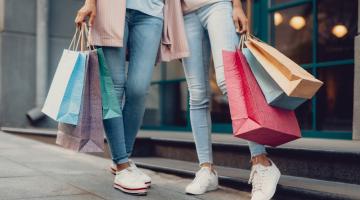
Consumers want more sustainable products from more sustainable businesses. While only 11% of consumers understand the term “circular economy,” retailers and suppliers are embracing circular thinking and practices to drive profitable, consumer-friendly sustainability solutions.
In traditional economic models, raw materials are converted into useful goods that are sold, used and sent to landfills. In contrast, the circular economy is an economy-wide effort to ensure useful products, materials and resources are reused and recycled. It is a system, as defined by the Ellen MacArthur Foundation, “where materials never become waste and nature is regenerated.”
Retailers are actively engaged in the creation of a more circular economy. They are developing or improving the elements that define circular retail business models. Some of these elements include:
Exploring resale and rental
Buying used or renting products instead of buying new reduces the materials and resources needed to meet consumer needs. Well-known brands like Neiman Marcus, Patagonia, REI, Gap, Levi Strauss & Co. and Coach sell “gently used” or “well-loved” products through a variety of resale business models. The global secondhand apparel market is expected to reach $350 billion by 2027, according to ThredUp, up from $177 billion in 2022.
Rent the Runway, Gwynnie Bee and Armoire rent fashion and accessories multiple times before offering the items for sale. Nuuly, now owned by Anthropologie parent company URBN, rents items to consumers from 300 apparel brands. It also operates a resale marketplace where consumers can buy and sell used items.
Resale and rental options go beyond fashion and apparel. IKEA buys and sells used IKEA furniture. Do-it-yourself consumers also regularly rent rather than buy tools, power equipment, chainsaws, ladders and more from retailers like Lowe’s and The Home Depot.
Reverse logistics is the backbone of the circular economy. The reverse logistics industry manages the collecting, sorting, repairing and refurbishing of products for resale or recycling. NRF acquired the Reverse Logistics Association to ensure NRF members have access to the latest information, technology and service providers powering the circular economy.
Improving reverse logistics operations
Reverse logistics is the backbone of the circular economy. The reverse logistics industry manages the collecting, sorting, repairing and refurbishing of products, components and materials for resale or recycling. It includes managing products returned by consumers, those damaged in transit, and excess and out-of-season inventory.
Decisions made during the reverse logistics process determine whether products are returned to store shelves to be sold as new, sold in resale channels, sold through discount retailers like TJ Maxx, Marshalls, Ross or Ollie’s Bargain Outlets, auctioned in lots to other resellers, donated to charity or recycled. Optimizing reverse logistics operations helps retailers ensure products are handled in ways that protect their highest environmental, social and economic value.
Promoting redesign, repair and refurbishing
Brands and retailers are working together to improve the durability of products, including making them easier to repair. Products that last longer reduce the materials and resources needed to make new products. Vivobarefoot designs its shoes to be more durable and easily repairable. Rather than buying a new pair of shoes or boots when the tread eventually wears away, consumers can have them repaired or choose to return them to the company so they can be repaired and resold to another consumer.
The Apple trade-in program ensures that the company collects older products for potential refurbishing and resale or for proper recycling. Through programs like Amazon Renewed, eBay Refurbished and Best Buy Outlets, retailers are repairing, refurbishing, repackaging and reselling products with the same warrantees as unopened products to create both environmental and financial benefits. Retailers are also tracking the reasons consumers return products and sharing the information with manufacturers so that they can improve products and reduce waste.
Refilling and reusing
Multiple retailers are exploring reuse and refill options for personal care, cleaning, pet care and food products as a way of reducing packaging waste. Retailers are also integrating reusable containers within their own operations. Walmart, for example, has piloted reusable containers for its home delivery program. Retailers also routinely rely on reusable pallets to move goods.
Facilitating recycling
When available space, logistics and economics align, retailers can choose to offer in-store recycling for specific product types. As part of its Beauty (Re)Purposed program, Sephora collects beauty product containers for recycling. Staples offers free in-store recycling for electronics, ink and toner cartridges, and batteries with small cash-back rewards for select products.
Depending on the product category, Best Buy offers free or low-cost recycling options for televisions, computers, cell phones, appliances, video games and more. Other retailers, including The Home Depot, Lowe’s and Ace Hardware, recycle batteries in select locations.
Retailers are also embedding other elements of the circular economy including buying renewable energy, investing in electric vehicles, decarbonizing ocean shipping and setting carbon reduction goals. To follow and contribute to the retail industry’s growing focus on the circular economy, be sure to attend NRF 2024: Retail’s Big Show in January and the Reverse Logistics Association conference in February.

